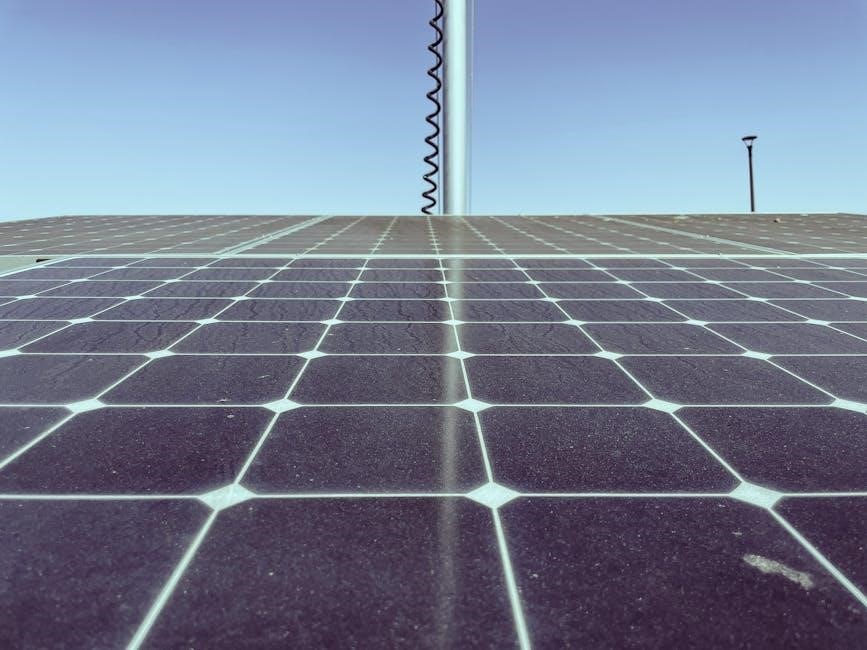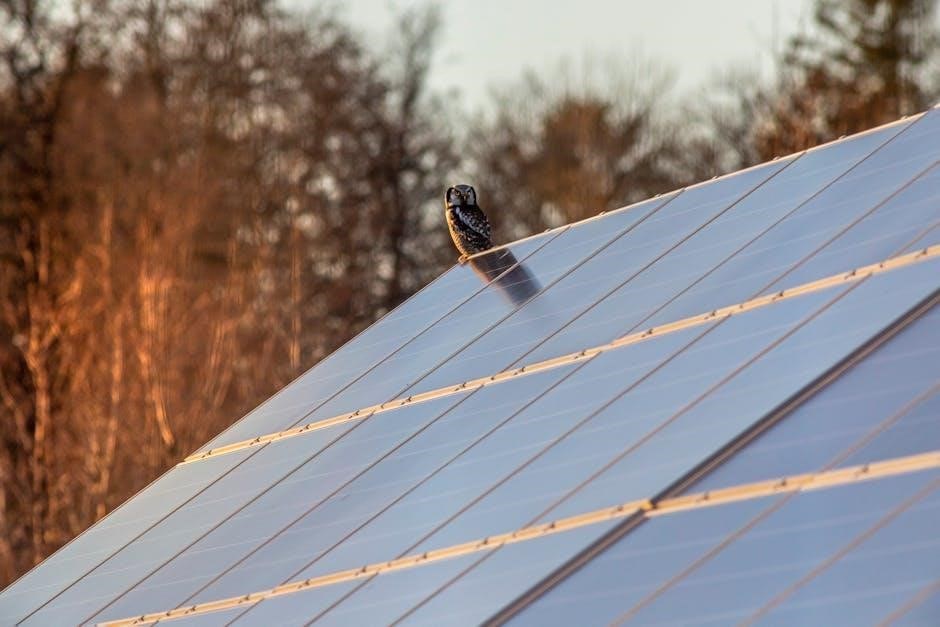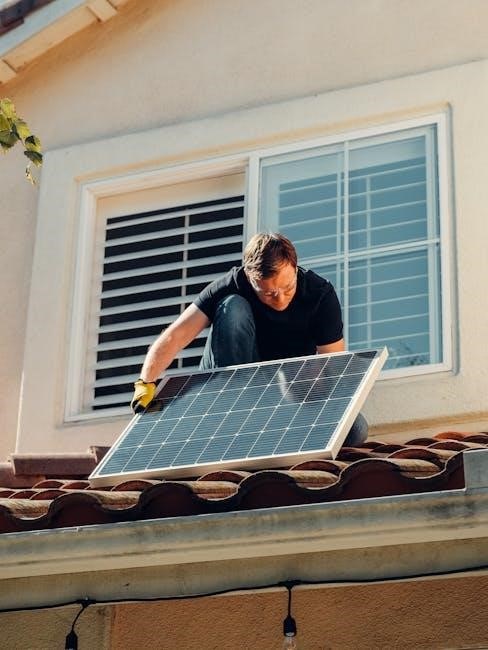
A solar panel wiring guide provides essential information on installing solar panels, including
- step-by-step instructions
and safety precautions, to ensure a secure and efficient solar power system, using proper always.
Importance of Solar Panel Wire Diagram
A solar panel wire diagram is crucial for understanding the electrical connections in a solar power system, providing a visual representation of the wiring to ensure correct installation and efficient operation. The diagram helps to identify potential issues and optimize system performance. By using a solar panel wire diagram, individuals can ensure that their system is installed correctly, reducing the risk of errors and safety hazards. A well-designed diagram also enables users to troubleshoot problems and make adjustments as needed. Furthermore, a solar panel wire diagram is essential for maintaining and upgrading the system, allowing users to add new components or modify existing ones with ease. Overall, a solar panel wire diagram is a vital tool for anyone installing or maintaining a solar power system, and its importance cannot be overstated in the context of solar panel wiring guide.
Benefits of a Well-Designed Solar Wiring Diagram
A well-designed solar wiring diagram offers numerous benefits, including improved system efficiency and reduced energy losses. It enables users to optimize their solar panel configuration, resulting in increased energy production and cost savings. A clear and concise diagram also facilitates easier installation, maintenance, and troubleshooting, reducing the risk of errors and safety hazards. Additionally, a well-designed solar wiring diagram allows users to plan for future expansions or upgrades, ensuring that their system remains scalable and adaptable. By providing a comprehensive visual representation of the solar power system, a well-designed diagram helps users to identify potential issues and make informed decisions about their energy needs, ultimately leading to a more efficient and effective solar panel wiring guide implementation, with a focus on maximizing energy production and minimizing costs, using various system components and configurations.

Understanding Solar Panel Connection Diagrams
Solar panel connection diagrams provide a clear visual representation of system components, using labels and symbols to identify connections always correctly and safely.
Visual Representation of Wiring
A visual representation of wiring is crucial in understanding solar panel connections, it uses diagrams and labels to identify components and connections, making it easier to install and maintain the system; The visual representation provides a clear overview of the wiring, allowing for easier identification of potential issues and troubleshooting. This representation is typically included in a solar panel wiring guide, which provides a comprehensive overview of the system’s components and connections. The guide includes information on the different types of wiring, including series and parallel connections, and provides tips for optimizing system performance. By using a visual representation of wiring, individuals can ensure that their solar panel system is installed correctly and functions efficiently. The visual representation is an essential tool for anyone installing or maintaining a solar panel system, and is used by professionals and DIY enthusiasts alike.
Optimizing Performance with a Smart Solar Panel Wiring Plan
Optimizing performance with a smart solar panel wiring plan is essential for maximizing energy production and minimizing losses. A well-designed plan takes into account the specific needs of the system, including the type and number of panels, the inverter, and the load. By using a smart solar panel wiring plan, individuals can ensure that their system is operating at peak efficiency, reducing energy losses and increasing overall performance. This involves careful consideration of factors such as wire sizing, connection types, and system configuration. A smart plan also allows for easy monitoring and maintenance, enabling individuals to identify and address any issues quickly. By optimizing performance with a smart solar panel wiring plan, individuals can get the most out of their solar panel system and enjoy significant energy savings. This is a key aspect of a successful solar panel installation.

System Design and Installation
Proper system design and installation are crucial for a functional solar panel wiring guide using
diagrams
and safety protocols always ensuring efficiency.
Panel Placement and Connections
Panel placement and connections are critical components of a solar panel wiring guide, requiring careful consideration of factors such as sunlight exposure and cable management. A well-designed system ensures that solar panels are installed in a way that maximizes energy production, while also minimizing the risk of damage or malfunction. The placement of panels should take into account the location of surrounding structures, such as trees or buildings, to prevent shading and optimize energy output. Proper connections between panels and other system components, such as inverters and batteries, are also essential for ensuring safe and efficient operation. By following a comprehensive solar panel wiring guide, individuals can ensure that their system is properly installed and maintained, with optimal panel placement and connections. This guide provides a detailed overview of the process, including diagrams and illustrations to facilitate understanding.
Examination of Panel and Wiring Integrity
The examination of panel and wiring integrity is a crucial step in ensuring the safe and efficient operation of a solar power system. This process involves inspecting the solar panels and wiring for any signs of damage or deterioration, such as cracks, corrosion, or worn-out connections. A thorough examination helps to identify potential issues before they become major problems, reducing the risk of system failure and minimizing downtime. The examination process typically involves visual inspections, as well as tests to verify the integrity of the panels and wiring. By examining the panel and wiring integrity, individuals can ensure that their solar power system is functioning properly and producing maximum energy output. Regular examinations can also help to extend the lifespan of the system and prevent costly repairs. Proper documentation of the examination results is also essential for maintenance and repair purposes.

Wiring Solar Panel Arrays
Solar panel arrays require careful wiring to ensure efficient energy production, using
- proper techniques
and materials always.
Series vs Parallel Wiring
When it comes to wiring solar panel arrays, there are two main configurations to consider: series and parallel. Series wiring involves connecting panels in a single line, while parallel wiring involves connecting panels in multiple branches. Each configuration has its own advantages and disadvantages, and the choice between them depends on the specific installation requirements. A series configuration can provide higher voltage, but it can also be more susceptible to shading losses. On the other hand, a parallel configuration can provide more flexibility and redundancy, but it can also be more complex to install and maintain. Understanding the differences between series and parallel wiring is crucial for designing and installing an efficient and reliable solar power system, using proper
- techniques
and
- procedures
to ensure maximum energy production. Proper wiring is essential for safety and efficiency.
Requirements for PV Modules with Microinverters
PV modules with microinverters have unique wiring requirements. Each microinverter is connected to a single PV module, and the output of each microinverter is connected to the grid or a battery bank. The wiring for microinverter-based systems is typically simpler than for traditional string inverter systems, with fewer components and less complexity. However, the wiring still requires careful planning and execution to ensure safe and efficient operation. The
- wiring diagram
for a microinverter-based system will typically show the connection of each microinverter to its corresponding PV module, as well as the connection of the microinverters to the grid or battery bank. Proper wiring is essential to ensure the safe and efficient operation of the system, and to maximize energy production. The use of microinverters can also provide
- additional benefits
such as module-level monitoring and optimization.

Setting Up a Basic Solar System
Setting up a basic solar system involves connecting solar panels to a battery and inverter using a
- proper wiring
configuration always correctly.
Connecting Solar Panels to Battery and Solar Panel Wiring Diagram
To connect solar panels to a battery, a solar panel wiring diagram is necessary, which provides a clear visual representation of the wiring configuration, including the type and size of wires, and the connections between the panels, battery, and other components. The diagram should be carefully followed to ensure a safe and efficient connection. A well-designed diagram will help to optimize the performance of the solar system and maximize the energy output. It is also important to consider the capacity of the battery and the charging requirements of the system. By following a proper wiring diagram, you can ensure a reliable and efficient connection between the solar panels and the battery, and enjoy a stable and sustainable source of energy. Using a
- step-by-step guide
can also be helpful in this process, making it easier to understand and implement the wiring diagram.